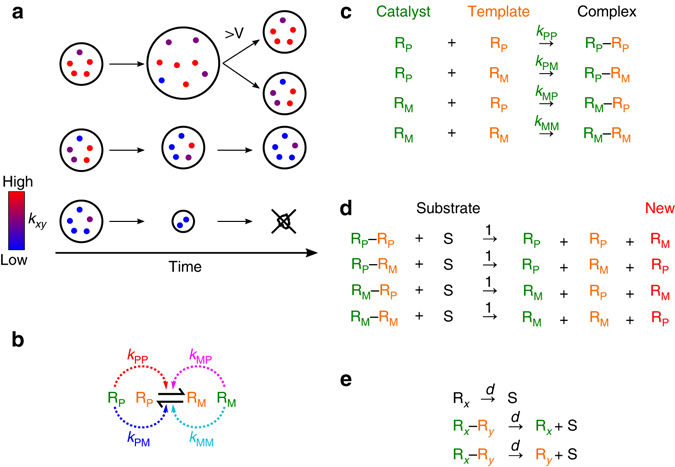対称性の自発的破れによる原始的ゲノムの起源
The origin of a primordial genome through spontaneous symmetry breaking
2017年8月15日 Nature Communications 8 : 250 doi: 10.1038/s41467-017-00243-x

現在の生命において、細胞の遺伝は触媒活性を持たない少数の鋳型分子、すなわちゲノムによってもたらされている。この様なゲノム分子は、原始的生命においてどのように誕生したのだろうか。本論文ではこれに対する答えとして、自己複製する分子の相補鎖間で対称性が破れることによりゲノムに似た分子が生じる可能性を提示する。我々の理論モデルは、触媒活性を持った自己複製分子を内部に複数含むプロト細胞(原始的細胞)の集団を想定する。プロト細胞は、自らの増殖速度を上昇させるため、内部に含む分子の触媒活性を最大化する方向へ進化しようとする。一方これとは逆に、分子は、各細胞内において自らが鋳型となり複製される相対頻度を上昇させるため、その触媒活性を最小化する方向へ進化しようとする。このような相矛盾する進化的傾向が細胞の階層と分子の階層で同時に働くことにより、分子の相補鎖間で対称性が破れる。すなわち、相補鎖の一方は触媒活性を維持しつつ、そのコピー数を増やし(酵素のような特徴を持つ分子)、もう一方は触媒活性を失い、かつそのコピー数を減らす(ゲノムのような特徴を持つ分子)。こうした非対称性は、突然変異圧の低下と細胞内の遺伝的浮動の増大をもたらすことにより、進化的平衡における細胞の適応度を増大させる。以上の結果は、複数の階層において相矛盾する進化が起きることが、遺伝的複雑性を生じさせる重要な原因のひとつであることを示唆する。
Corresponding Author
The heredity of a cell is provided by a small number of non-catalytic templates—the genome. How did genomes originate? Here, we demonstrate the possibility that genome-like molecules arise from symmetry breaking between complementary strands of self-replicating molecules. Our model assumes a population of protocells, each containing a population of self-replicating catalytic molecules. The protocells evolve towards maximising the catalytic activities of the molecules to increase their growth rates. Conversely, the molecules evolve towards minimising their catalytic activities to increase their intracellular relative fitness. These conflicting tendencies induce the symmetry breaking, whereby one strand of the molecules remains catalytic and increases its copy number (enzyme-like molecules), whereas the other becomes non-catalytic and decreases its copy number (genome-like molecules). This asymmetry increases the equilibrium cellular fitness by decreasing mutation pressure and increasing intracellular genetic drift. These results implicate conflicting multilevel evolution as a key cause of the origin of genetic complexity.

